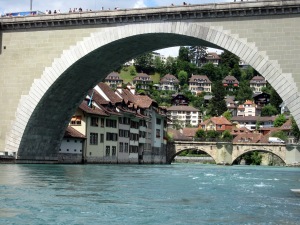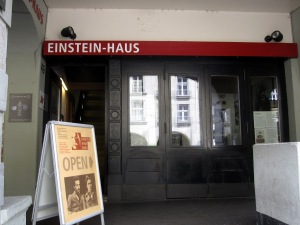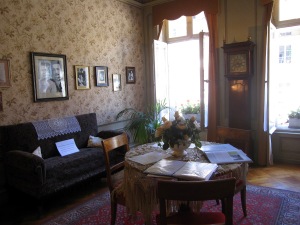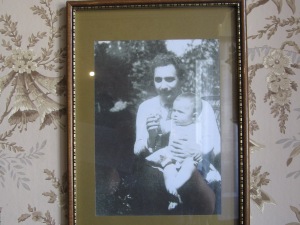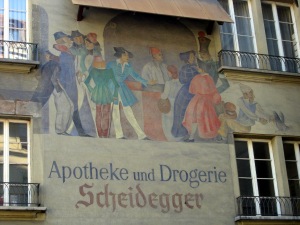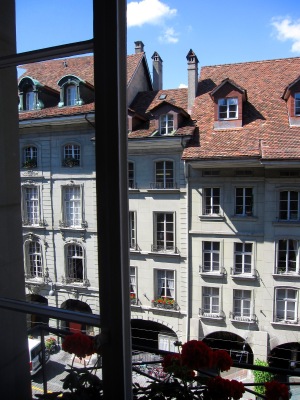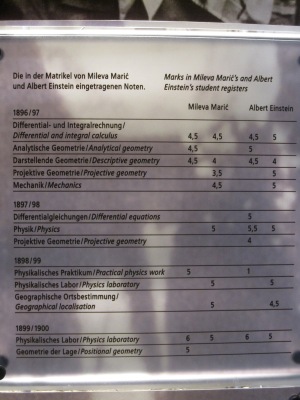Clockwise: the Aare River meanders through Bern; the flag of the Bern canton features a bear; chess players pondering in the park; the intricate astronomical dial of Bern’s largest clocktower displays the day of the week, day of the month, sunrise, sunset and zodiac signs
Bern is a city of about 350,000 people, and as the capital of Switzerland, is both the physical and legislative center of the nation. A train transfer is required here to get from Zurich to Interlaken, so we stopped and spent the day wandering Bern’s historic district, which happens to be a UNESCO World Heritage Site.
The city was founded in 1191 by Duke Berchtold V, who according to legend, named it after a bear he had killed. In 1848, it became the capital of Switzerland. The city is centered on a peninsula formed by the Aare River, and though it has since grown past these embankments, the medieval old town is still highly compact and easily explored in an afternoon on foot. With over six km of covered shopping arcades, it is also an excellent place to spend a rainy day.
Clockwise: Bern’s Zytglogge clocktower dates from the 13th century; view of Bern through one of the town’s many bridges; the crowd looks down into the bear pit
In the center of town is Bern’s most prominent feature, the Zytglogge clocktower. Since the 13th century, it has served as the town’s civic center, watchtower, clocktower, and a prison (housing Pfaffendirnen or “priests’ whores,” or women convicted of sexual liaisons with clergy). Every hour on the hour, there is a show with moving puppets. Unfortunately, the demo that we were watching was sadly lackluster, with just one lazily circling puppet. Perhaps the puppets were in need of repair?
If you head to the end of the peninsula and cross the river, you will see Bern’s infamous Bärengraben, or bear pits. The bears now live in BärenPark, an open-air park along the Aare River. Speaking of the river, urban swimming is very popular in Switzerland, and the Aare is no exception. On a hot summer day, you will see local residents take a dip in the river. Can you imagine doing this in the East River? Be warned that the current can be quite swift, especially around bends.
Clockwise: The Einsteinhaus preserves Einstein’s original Bern apartment; Einstein’s living room around the turn of the century; one of many old murals and signs in Bern’s Old Town; Einstein cradles his first son, Hans Albert
For a physically engaging experience, I recommend stopping by Einsteinhaus (near Zytglogge) at Kramgasse No. 49. This is a preserved flat rented by Einstein when he was living in Bern from 1903-05, working as a “3rd class technical expert” at the Swiss Patent Office. While there, Einstein published the Annus Mirabilis papers (“Miracle Year”), a series of four articles that laid that foundation for modern physics, including ideas on the photoelectric effect, Brownian motion, special relativity, and matter and energy equivalence. Yes, that world-famous equation E = mc² was formulated here. At the time, he was just 26 years old. (Oh dear, and what have I done with my life?) The work on the photoelectric effect would later be the basis of Einstein’s 1921 Nobel prize.
Even if you are not interested in the science, Einstein’s personal story here in Bern is also compelling. At the time, he was married to Mileva Marić, a classmate from Zurich Polytechnic. Marić became pregnant by Einstein, and in 1902, gave birth to a daughter whose fate is unknown and may have been given up for adoption. Under parental pressure, Einstein and Marić married in 1903 and moved to Bern. The living room is decorated with several photos of the happy couple and their first son, Hans Albert, and Einstein later described these years in Bern as some of the happiest of his life. Marić was a talented scientist on her own, and is thought to have had some influence on the development of Einstein’s work, though it is unclear how much.
Surveying downtown Bern from Einstein’s living room window; a comparison of Einstein’s grades with those of Mileva Marić, his first wife
Unfortunately, in 1912, Einstein began having an affair with his first cousin, Elsa Löwenthal. The marriage with Marić was dissolved on Valentine’s Day in 1919, and Einstein married Löwenthal four months later. She later emigrated with him to the United States, where Einstein worked at the Institute for Advanced Study at Princeton.
Admission is CHF 6/4.50 with a student ID.





